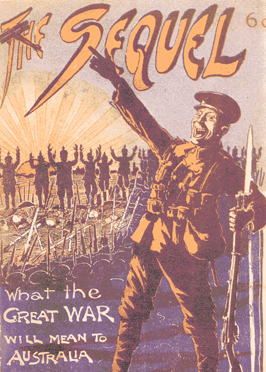
George
Augustine Taylor's 1915 novel, The
Sequel
(the gaudy cover-illustration is his)
IN
TAYLOR'S 1915 novel, The Sequel (its full title
was The Sequel - What the Great War Will Mean to Australia),
the name "Cooley" appears twice.
The first reference comes half-way through the text. Outlining
his view of the future, the hero (a young aviator called
Jefson) says: "A great writer* once said..."
The asterisk* reference is at the bottom of the page,
and it says: "*Stoughton Cooley" [sic]. Nothing
more - just that name.
The second reference to Cooley in The Sequel is
only slightly more extended.
He is portrayed in the novel as a visionary who believes
that aviation is the shape of things to come. This Cooley
- no first name, no nationality - is the sworn enemy of
socialism. In America he sees great engineering works,
like the Hudson Tunnel in New York, the product, he asserts,
of the benefits of capitalism.
As Taylor himself had travelled to America in 1914, the
year before The Sequel was published, it is hard
to escape the inference that the second Cooley is a self-portrait
of Taylor.
This Cooley certainly espouses similar conservative views
that Taylor put forth in his various publications. His
magazine, Builder, ran regular editorials espousing
conservative values. (Had he lived long enough, he would
have been a great fan of Ayn Rand.)
When I wrote my 1981 book, I put forward the theory that
the name Cooley was Irish, and I later speculated, in
an article in Rananim on Lawrence's transposition
habits, that Lawrence was using his opposites-transposition
to disguise the real-life characteristics of Charles Rosenthal,
an avowed protestant.
But I am now certain that Taylor got, and borrowed for
himself, the name "Cooley" from Stoughton Cooley,
who turns out to have been a fellow publisher/editor,
and whom Taylor could well have met - and probably did
- on his trip to America in 1914.
At that time Stoughton Cooley was the assistant editor
of a magazine in America called The Public, which
was a journal devoted to promoting the social and political
ideas of Henry George.
Henry George is a name not well known today, but in the
years around the turn of the last century he was said
to be the third most famous man in America, behind Thomas
Edison and Mark Twain.
